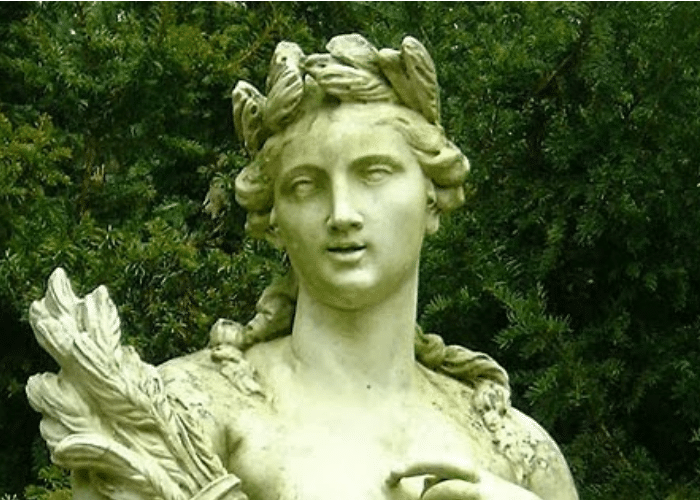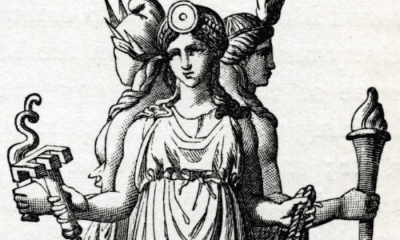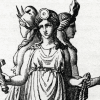
Greek
What Was Demeter the Goddess Of?
What Was Demeter the Goddess Of?
Demeter was a maternal goddess of Greek mythology who was so powerful that even Zeus and Hades had reason to fear her.
Demeter was the Greek goddess of agriculture, specifically of cereal grains. As most Greeks lived on a diet of primarily bread, she was one of the most widely venerated goddesses in the pantheon.
But Demeter is most often remembered for the time she spent abandoning her duties and her threat to withhold her gifts from men and the gods. When the maternal goddess’s child was threatened, Demeter would see all of humanity starve to get her back.
In the end, Demeter made the grain stop growing for just a few months every year. Winter was the time when her beloved daughter was taken to the underworld, to rise again in the spring and bring fresh growth with her.
As a goddess of growth, nourishment, and fertility, Demeter was closely connected to the primordial mother goddess Gaia. In fact, many of the most important goddesses in Greek mythology shared a common connection to ideas of life and growth.
Demeter and the Earth
Demeter was one of the six original deities of Olympus. She was the sister of Zeus, Hera, Poseidon, and the other children of Cronos and Rhea.
Like most of her siblings, Demeter was swallowed at birth by her father. Only Zeus was spared this fate, and when he returned to free his siblings they fought their father and uncles for power.
Of Zeus’s three sisters, Demeter was probably the most important goddess in the lives of the people of Greece. She was a goddess of the harvest, specifically of grains and cereals.
Like most ancient Indo-Europeans, bread made of the majority of the diet for most people in Greece. The goddess of grain was, therefore, essential to their survival.
Although she was a fertility goddess, Demeter never married. She did, however, have children.
The most well-known of Demeter’s children was the child she had with her brother, Zeus. Persephone was her mother’s closest companion and the subject of Demeter’s most famous legend.
Zeus arranged for Persephone’s marriage without Demeter’s knowledge. He knew his sister would object to the match because he planned to marry her to their brother, Hades.
Hades was a powerful god, but he ruled over the dark realm of the underworld and rarely came to earth’s surface. Zeus knew that Demeter would never consent to have her daughter taken to the underworld, even if it was as that realm’s queen.
Instead, Zeus planned for Hades to abduct Persephone when Demeter was not with her. The younger goddess seemed to simply disappear.
Demeter wandered the world in search of her daughter before finally learning the truth from Helios, who had witnessed the kidnapping from his position high in the sky.
Furious, the goddess demanded that she be allowed to see her child again. If Zeus refused she would abandon her duties, leaving humans to starve and preventing the other gods from receiving any sacrifices.
Under such a threat, Zeus ordered Hades to bring Persephone to the surface. She and Demeter were reunited, but it was too late to prevent the younger goddess from becoming the queen of the underworld.
Rather than incur Demeter’s wrath any farther, Zeus and Hades agreed to a compromise. Persephone would be allowed to spend most of the year with her mother, but one third of her time would be spent with her husband in the underworld.
Thus, for a third of the year grains and vegetables stopped growing. The story of Demeter and her missing daughter was used to explain the cycle of seasons in the Greek world.
Demeter and her beloved daughter also showed the connection the Greeks made between the realm of the dead and the fertility of the earth.
Plants grew from the ground, so it stood to reason that their origin was in the underworld far beneath the earth’s surface. Bodies were placed in the ground to go to the realm of the dead, but plant life was believed to have its roots there.
When Demeter’s daughter returned to the surface every spring to rejoin her mother, grains and other plants began to grow and flourish again. The fertility of the earth relied on the afterlife.
Thus, although they were goddesses of fertility and nature, Demeter and Persephone also had a role as chthonic, or underworld, deities. Fertility and the dead went hand in hand.
Because she brought her daughter back from the realm of the dead each year, Demeter also played a role in the mystery cults of Greece. These cults sought to understand death and the afterlife, and Demeter provided a link between the living world and the realm of Hades.
Demeter is often thought of as a nurturing and maternal goddess. But the Greeks also understood that she had the power to bring death by starvation to the entire world and could make even Zeus and Hades bend to her will under that threat.
My Modern Interpretation
Demeter was one of many goddesses who served a function in the growth of living things. The fertility goddesses of ancient Greece were so intrinsically linked that some historians consider them to be aspects of one power.
Demeter and Gaia in particular worked closely together. Some stories said that Gaia was the mother of all things except cereal grains, which were the creation of her granddaughter, Demeter.
A modern reading suggests that Demeter was not simply an ally of Gaia, but a more specific aspect of the goddess of the earth.
The Mother Earth archetype, which in Greece was represented in the form of Gaia, was generally regarded as the source of all life. According to some modern interpretations, Demeter was the embodiment of a specific aspect of Gaia, the growth of food crops, much as the minor gods were representative of specific features of more important Olympians.
Rhea, Demeter’s mother, was sometimes seen as another version of the same mother goddess. Her only real function in mythology was to give birth to the primary gods of Olympus, making Rhea another likely candidate for a specific aspect of the mother archetype.
The story of Persephone’s birth is sometimes said to show a link between Demeter and Rhea. There is no further mention of a relationship between Zeus and Demeter, making Persephone’s birth an unusual case of the goddess being cast as a mother with no further context, just as Rhea was.
In fact, the end of Demeter’s name contains the same root as “mother,” further evidence that she was closely linked to the archetype shared by both Gaia and Rhea.
There was a belief in some parts of Greece that Demeter and Persephone themselves were one and the same. Winter was believed to be caused by the disappearance of the goddess of agriculture, not her daughter.
Even Aphrodite can be seen as another aspect of Demeter and, by extension, the Gaia type. The goddess of beauty was linked to human fertility and reproduction in the same way Demeter and Gaia were linked to the proliferation of plants and animals.
Under this interpretation, many of the goddesses of the Greek pantheon can be seen as variations on the same mother archetype. While the Greeks developed individual legends and personalities around these characters, each could be seen as an aspect of the life-giving archetype of Gaia.
In Summary
Demeter was a Greek goddess of agriculture and the harvest. She was particularly associated with the growth of grains, which made up most of the diet of the majority of ancient people.
In this role, she was one of the most important goddesses in the pantheon. Without her, the people and animals of the world would face mass starvation.
Demeter threatened to cause just such a catastrophe when her daughter, Persephone, was kidnapped and made the bride of Hades. If she was not allowed to see her daughter she would make the grains that fed humanity stop growing.
This was such a powerful threat that it forced Zeus and Hades to negotiate with their sister. Demeter had the power to make even the king of the gods meet her demands.
Demeter won the right to spend two thirds of the year with her daughter. The time Persephone spent in the realm of Hades was winter, when the grains stopped growing as her mother waited for her to return.
Some Greeks believed that Demeter herself was the bride of Hades and that she and Persephone were one and the same. Forming the connection between death and new life, the return of the fertility goddess from the underworld corresponded to the return of plants from beneath the surface.
Demeter, and by extension her daughter, can also be seen as aspects of a broader goddess archetype.
Gaia was the Mother Earth of Greek mythology, the primal being from which all life and the gods arose. The mythology of Greece was unusual in that they specified that Demeter, rather than the primordial earth mother, was the creator of grains.
Demeter and other maternal goddesses can be seen as specific aspects of Gaia rather than separate entities altogether. In this interpretation Gaia was the root of all life and Demeter was the name given to the part of her that caused grains to grow.
The Mother Earth archetype is one of the most common in religions from around the world. As a maternal goddess of the harvest, Demeter fits into that type whether she was always an individual or was once part of a more ancient being.



